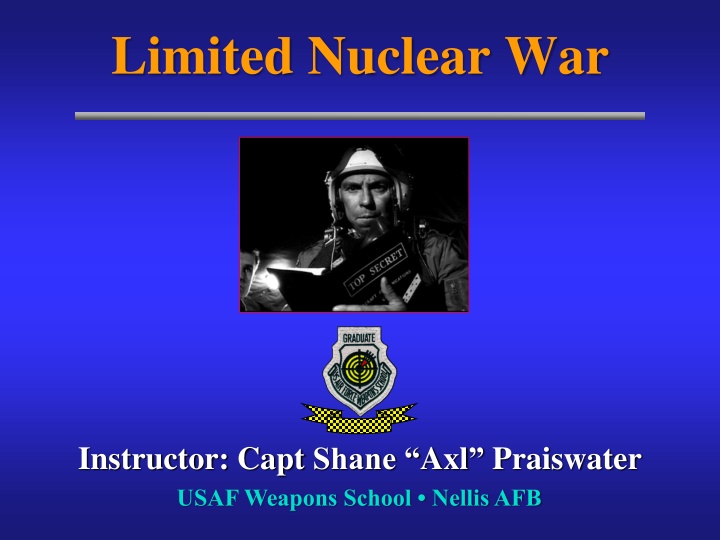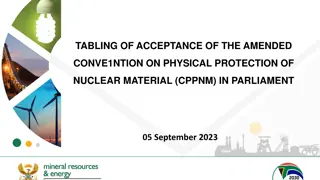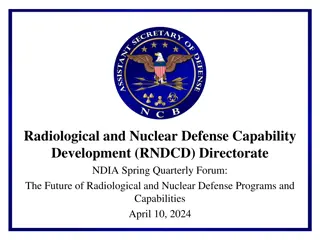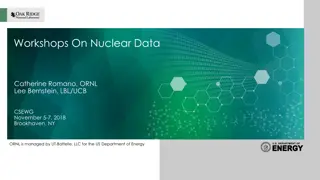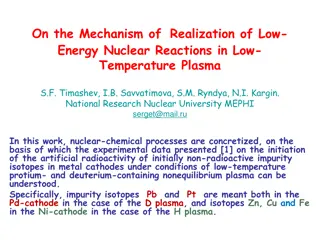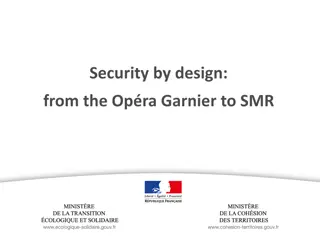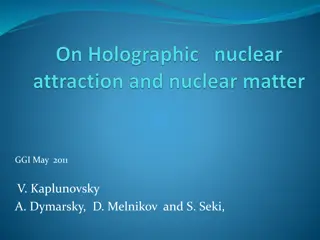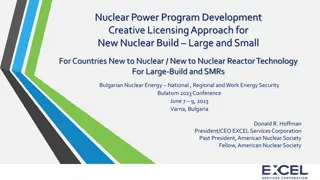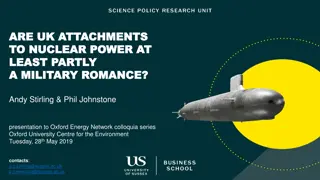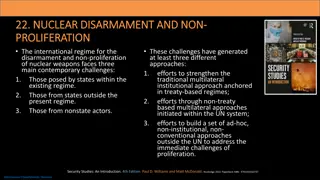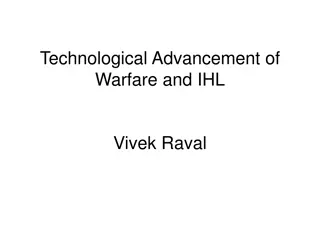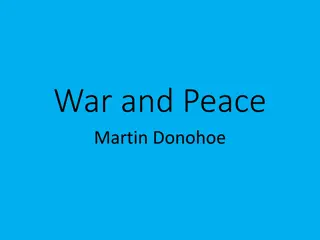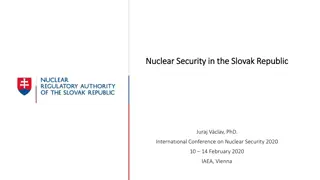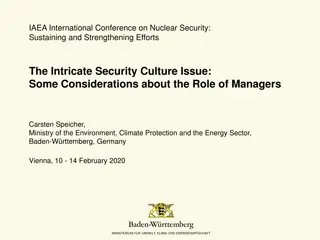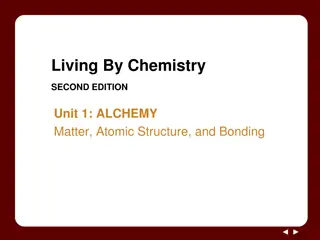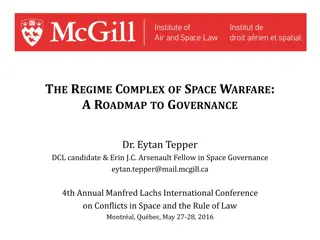Limited Nuclear Warfare: Strategic Insights for National Security
Delve into the complexities of limited nuclear warfare with a focus on strategic decision-making, adversary motivations, and maintaining stability in times of conflict. Explore the theoretical frameworks and practical considerations surrounding the use of limited nuclear options to achieve strategic objectives while safeguarding national interests. Gain valuable insights from expert briefings and discussions on the nuances of nuclear deterrence in a dynamic geopolitical landscape.
Download Presentation

Please find below an Image/Link to download the presentation.
The content on the website is provided AS IS for your information and personal use only. It may not be sold, licensed, or shared on other websites without obtaining consent from the author.If you encounter any issues during the download, it is possible that the publisher has removed the file from their server.
You are allowed to download the files provided on this website for personal or commercial use, subject to the condition that they are used lawfully. All files are the property of their respective owners.
The content on the website is provided AS IS for your information and personal use only. It may not be sold, licensed, or shared on other websites without obtaining consent from the author.
E N D
Presentation Transcript
Limited Nuclear War Instructor: Capt Shane Axl Praiswater USAF Weapons School Nellis AFB
Classification Slides are to the UNCLASSIFIED level Discussion may be up to and including the UNCLASSIFIED level 1
Disclaimer Views expressed in this brief do not necessarily represent those of the US government 2
Intel Brief (theoretical) China masses for an unexpected invasion of Taiwan Recent months have seen massive protests demanding democracy after revelations of high level corruption US has insufficient forces in the region to guarantee the security of Taiwan and counter A2AD: JCS recommend a limited nuclear strike on massing Chinese forces 3
Limited Nuclear Theory Inflicting a limited amount of punishment sufficiently credible that the adversary no longer finds it worthwhile to continue the confrontation Total nuclear war is inherently irrational: with secure adversaries. Information/intelligence is crucial: effectively advertising is imperative. States prefer relatively smaller, less-destructive options 4
Limited Nuclear Theory Q represents the adversary accepting the status quo and ending the conflict on the given terms 5
Keeping it Limited We can remain static on the limited model if internal power structures are maintained and ambiguity is limited With ambiguity, traditional risks are maintained. Goal is to compel the adversary to Q SecDef Mattis: First use may occur as last resort of self-defense 6
Motivating Factors Adversary Goals 1: Maintain internal power: clear rationality 2: Expand regional prowess Assumption: nationalism is a tool for modern authoritarians, not a motivating factor Access to information is key towards determining if these goals are threatened. 7
Briefing Example FOOTSTOMPS: If one goes up, they all go up is a dangerous misconception Attitude is completely opposite to the US nuclear attack structure Game theory always dictates that the safest course of action is to not launch nuclear weapons The ability to launch nuclear weapons may be more important than the explosions themselves 8
Limited Variables Target Suitability: Are nuclear weapons required to defeat a specific target Does the adversary have retaliation capabilities Does the strike threaten adversary s grip on power: Is the contested objective integral to adversary s legitimacy? The use of strategic weapons can be constrained to the tactical environment Transparent Motives Can the adversary objectively determine motives of US? 9
Variables 1) Target and objectives require the use of a nuclear weapon (conventional options insufficient). US justifies as last resort of self-defense to an ally . 2) Chinese Power Considerations - Strike on massing forces does not directly threaten CCP s ability to stay in power - Best Case: attack unifies Chinese people with CCP - Worst Case: attack makes CCP seem weak, opposition emboldened 10
Variables (cont) 2) Chinese Power Considerations (cont) - Retaliation does not guarantee mission success - Ex: China can destroy PACAF bases, but this does not necessarily help Taiwan objective - However, if internal power is in question, China can retaliate without risking escalation, IF they avoid massing for Taiwan - Conclusion: - Nuclear war for Taiwan remains limited as long as Taiwan does not determine CCP s fate 11
Limited Model (w/Info) Nuc. Kadena Inv. Stopped Does not enable invasion Retaliate or de-escalate? China Inv. Forces Struck No. Taiwan clearly the only obj. Retaliate or de-escalate? Threat to CCP? 12
Limited Model (w/Ambiguity) Nuc. Kadena? Inv. Stopped Does not enable invasion Retaliate or de-escalate? China Inv. Forces Struck Threat to CCP? Threat to CCP? No. Taiwan clearly the only obj. Retaliate or de-escalate? escalate? Retaliate or Escalate Unknown Yes Threat to CCP? B-52s Dept. Minot B-52s Dept. Minot, Artificial Islands Destroyed 13
Other Examples In this retaliation scenario, how should the US react to a nuclear attack in PACOM that does not threaten the integrity of Taiwan? How should the US react to a nuclear attack by North Korea? 14
Policy Recommendations US should clearly establish respect for adversary power structures for peers (i.e. Russia and China) Even if this changes, reducing ambiguity allows for a tactical advantage Establishing clear respect allows for more aggressive diplomatic, economic, and military (to include 1st strike) capabilities: signaling. US may specifically threaten power structure of regional threats (while creating incentives). Invest heavily in defensive systems (anti-ballistic) 15
Questions? Instructor s name: Capt Shane Axl Praiswater Instructor s address: 340th Weapons Squadron 50 Vandenberg Ave, Ste 107 Barksdale AFB LA 71110 Instructor s phone: 512-656-5903 Instructor s e-mail: shane.praiswater.1@us.af.mil 16
